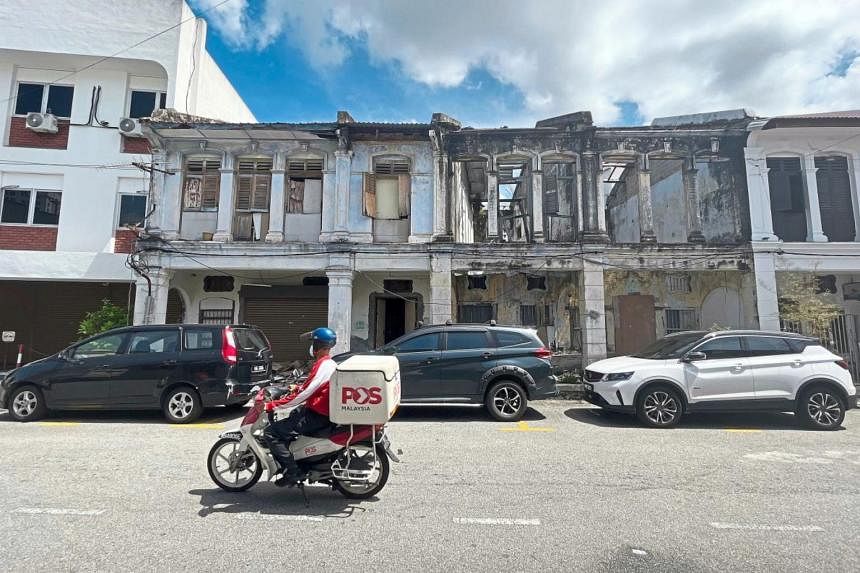GEORGE TOWN (THE STAR/ASIA NEWS NETWORK) - Landed properties valued at more than RM500 million (S$157 million ) are rotting in space-scarce Penang island, where residential and commercial buildings fetch lucrative prices.
Penang Island City Council (MBPP) councillor Wong Yuee Harng said that while more than RM300 million worth of heritage and pre-war buildings (commercial and residential) were left unoccupied, several buildings put up later were in a similar predicament due to the Covid-19 pandemic.
The abandoned post-war buildings in the city were valued at some RM200 million, according to a property valuation consultant.
These post-war buildings are all over the island with many having turned into a breeding ground for mosquitoes and snakes, and turning into dumpsites.
Mr Wong said MBPP was able to get some of these property owners to clean and maintain their buildings.
It is easier to monitor buildings within the heritage area, which are pre-war residential or commercial buildings. The council's building department has the right to hoard up the buildings or even charge the owners while the Health Department can move in to clean the area and bill the owners," Mr Wong said in an interview.
Since The Star reported in 2017 that there were RM20 million worth of post-war properties in Jalan Masjid Negeri and Lebuh Bukit Jambul, more have cropped up.
Mr Wong said there were 97 such properties in 2019 (excluding 70 pre-war properties) and the council managed to locate several of the owners to restore the buildings.
"The biggest issue we are facing is to locate the owners or next of kin who may have migrated, or they could have passed away.
"Some of them have legal firms to handle matters such as quit rent but there are others from large families whom we are unable to locate," he said.
Under the Local Government Act, owners could be fined RM1,000 or jailed not more than six months or both, plus fined not more than RM100 a day, if the offence "continues after conviction".
Sections 127 and 128 of the National Land Code allow alienated land to be forfeited by the state.
According to another property consultant, a property in George Town was worth RM750 to RM1,100 per sq ft (land only) and RM400 per sq ft in Tanjung Bungah and Bayan Lepas (land only).
"As such, with the high price of landed property, about 30 to 40 abandoned or unoccupied properties on the island are worth almost RM200 million, which is a loss to the council as it will not be able to collect quit rent, what more if it is in a prime area," said the consultant.
A director of a renowned property valuation company said the Covid-19 pandemic should also be taken into account as many properties were left unoccupied due to financial reasons over the last two or three years.
"Since we are transitioning to an endemic phase, business activities are seeing a revival. There will be those who can afford to buy the post-war abandoned properties.
"We do not really have the issue of family disputes where properties are abandoned, something which existed before the repeal of the Rent Control Act.
"Today it is more of a financial issue, or owners being overseas and not being aware of the properties they own.
"Even pre-war buildings are being restored as it has financial value. Newer landed properties fetch a high price," added the director.
The issue of abandoned private landed properties was brought up at a recent State Assembly sitting by Ayer Itam assemblyman Joseph Ng, who said unoccupied properties created problems due to the unkempt conditions.
Ng urged MBPP to act against the errant owners and look into ways to impose stiff fines on them.
He said council workers should not be burdened by the problem, saying it was beyond their scope of work to clean private properties.
Meanwhile, a spokesman from the Melaka Heritage Trust said the state also faced a similar problem with regard to the older buildings and homes located in the heritage and buffer zones.
"Some of these homes are willed down by families with a condition that it can only be sold by the son from the third generation.
"Until that happens, who in the family is going to take responsibility for the upkeep of the homes?" she asked, adding that there might also be family members contesting the ownership.
She cited a case in Melaka where the person living in a heritage home was murdered, with the victim's surviving brother in Kuala Lumpur also passing away later.
"The issue is which family has ownership over the home. No one came forward to make any claim and the home has since been left abandoned," she added.
The spokesman said legal uncertainties over the rightful ownership of a property among family members would usually result in such homes being left abandoned.
"It is everyone's house but no one's home in the family. Would you want to spend thousands maintaining the home only to have a family member come forward to sue you?" she pointed out, adding that local authorities were usually left in a quandary on what to do with such dilapidated homes.
"The local council has little experience dealing with such properties and don't want to be drawn into a lengthy court battle over their ownership," she added.
The spokesman said local councils would only have the right to step in to clean up or board up the dilapidated homes if it posed a public health threat.

